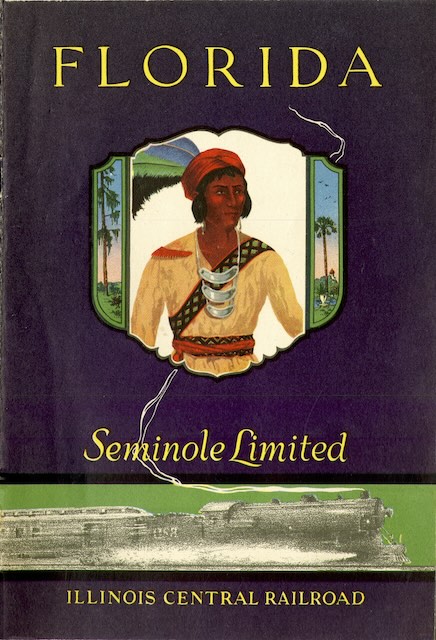With a pink flamingo on the back representing Florida and a Native American on the front representing the Seminoles (and therefore the train), this booklet describes Illinois Central’s entry into the competition for Midwest-Florida traffic in the early 1920s. IC was the original carrier of the Dixie Flyer from Chicago, but in 1908 Louisville & Nashville switched to the Chicago & Eastern Illinois. In response, IC inaugurated the Seminole Limited in 1909 and put it on a schedule that was three hours faster than the Flyer.
 Click image to download a 13.1-MB PDF of this 36-page booklet.
Click image to download a 13.1-MB PDF of this 36-page booklet.
The competition quickly caught up, which would have been easy as their routes were almost exactly the same length: 1,128 miles via the Illinois Central vs. 1,130 miles on the Dixie Flyer. The Seminole left Chicago at 8:15 pm and arrived in Jacksonville at 7:45 am two mornings later, while the Dixie Flyer left Chicago 50 minutes after the Seminole but arrived in Jacksonville just 40 minutes after. On the return trip the Dixie Flyer left Jacksonville an hour before the Seminole and arrived in Chicago an hour before.
This booklet played a dirty trick on Illinois Central’s competitors. The map on page 30 highlights the IC route in red and also shows the lines of its competitors. This includes the Chicago & Eastern Illinois line from Chicago to Evansville, the Louisville & Nashville line from Evansville to Nashville, and the Central of Georgia/Atlantic Coast Line route from Chattanooga to Jacksonville. But the mapmaker left out the key link in the Dixie Flyer chain, namely the Nashville, Chattanooga & St. Louis line between Nashville and Chattanooga. This made it appear that IC had no real competition in the Chicago-Florida market.
Railroads often made their own lines appear straighter than they really were while leaving the circuitous nature of their competitors on their maps. But they rarely left key competitors off the maps: either they showed all other railroads or none. This omission had to have been a conscious decision on the part of Illinois Central officials.
Aside from the map, this booklet contains four pages describing the route from Chicago to Florida, 19 pages on resorts and sights to see in Florida, and a page on Cuba. All of this is preceded by two pages on the “speed, reliability, and excellence of the Seminole Limited.” This was an “electric-lighted, all-steel train,” which wasn’t yet true of all premiere trains in 1922.
The booklet notes that the train had an “observation sleeping car,” which reveals that the amenities aboard that observation car were limited. The truly luxurious trains had an observation-lounge car, perhaps with a barber, men’s and women’s lounges, and a buffet in place of sleeping rooms or berths. The booklet adds that the train had “attractive, commodious dining cars” that served “tip-top meals.” In 1922, the Dixie Flyer had a diner between Evansville and Jacksonville, which was enough because the Chicago-Evansville portion of the route took place at night.
In short, the Seminole and Dixie Flyer were probably equal in almost every respect. The Seminole did arrive in Jacksonville a few minutes earlier and left for Chicago a few minutes later, thus giving vacationers an extra hour and 40 minutes time in Florida. But this really might have been a disadvantage for anyone whose destination wasn’t Jacksonville itself, since both trains connected to the same trains to Tampa/St. Petersburg or Miami, which meant the extra 1-2/3 hours would be spent sitting in the Jacksonville train station.
